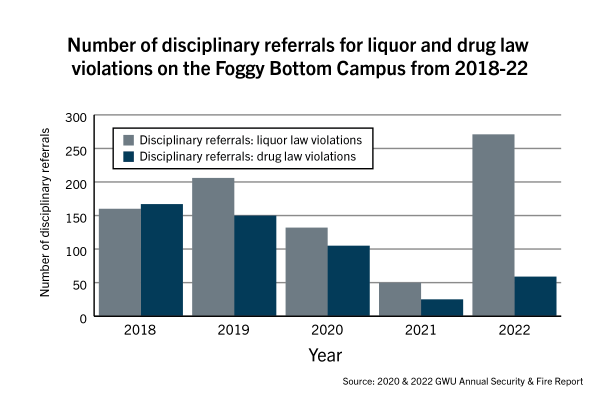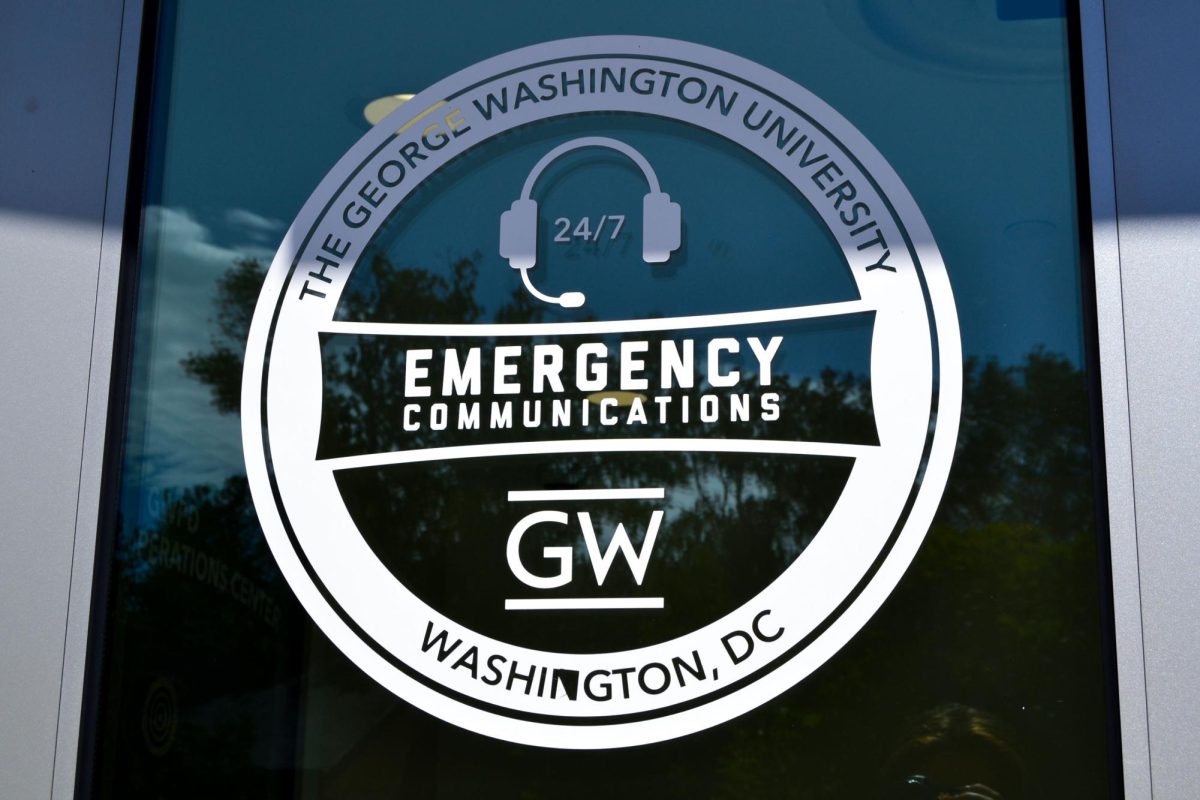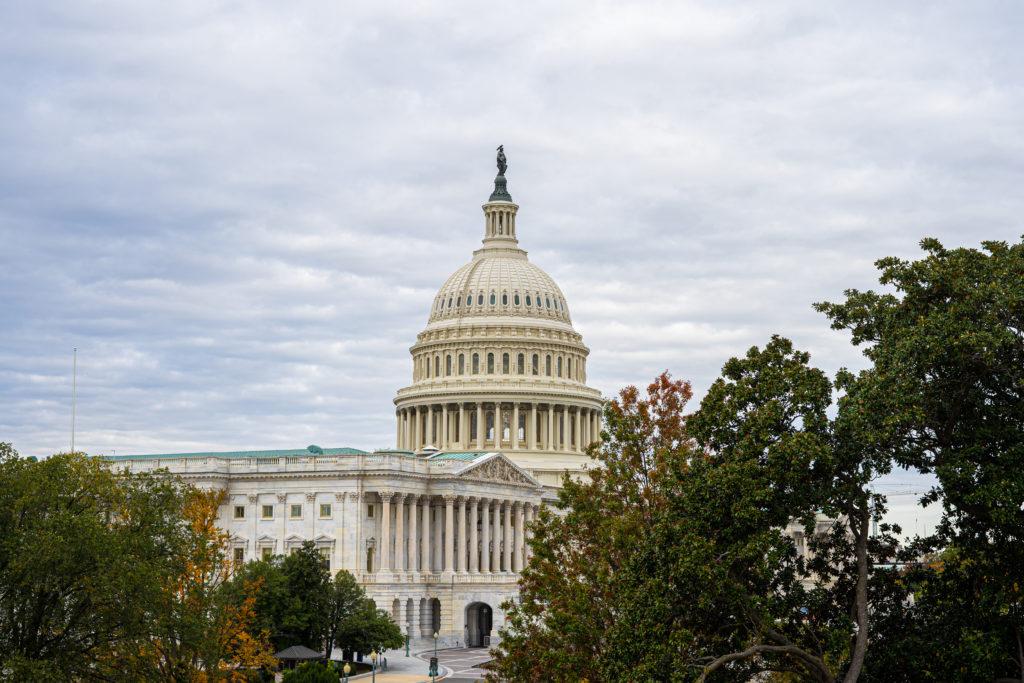Disciplinary referrals for liquor law violations spiked between 2021 and 2022, while reports of fondling decreased by more than half, according to GW’s Annual Security & Fire Safety Report released last month.
The annual report — which officials are required to submit under the federal Clery Act, legislation that aims to provide transparent crime data for college campuses that receive federal funding — includes data on crimes reported to the GW Police Department, like liquor law violations, domestic violence, stalking, dating violence and robbery. Criminology experts said the 2022 data in the report align with the increased activity resulting from a return to campus after the COVID-19 pandemic but that it’s difficult to extrapolate crime trends from the small data set.
University spokesperson Julia Metjian said the reopening of campus in 2022 led to “increased activity” compared to 2020 and 2021.
“GWPD prioritizes the safety of our University community and continues to employ all necessary resources to address issues as they arise,” Metjian said in an email. “GWPD will continue to strive to meet the evolving needs of the GW community and foster a safe campus environment for all.”

Officials reported 271 disciplinary referrals for liquor law violations on the Foggy Bottom campus in 2022 after 50 in 2021 and 132 in 2020 — the jump in liquor law violations coincided with students returning to campus following COVID-19. Disciplinary referrals occur when GWPD refers individuals to the Office of Student Rights and Responsibilities, per the report. In the five years of available data on GWPD’s website, disciplinary referrals for liquor law violations were highest in 2022 at 271.
Disciplinary referrals for drug law violations on the Foggy Bottom Campus plummeted from 105 to 29 between 2020 and 2022, and referrals for drug law violations on the Mount Vernon Campus climbed from five in 2020 to 30 in 2022. Over the last five years, disciplinary referrals for drug law violations were highest in 2018 at 167.
Reports of fondling on the Foggy Bottom Campus decreased from 20 in 2021 to eight in 2022, while reports of rape increased from eight in 2021 to 12 in 2022. GW directs students to the Office of Advocacy and Support and the Title IX office to report cases of sexual violence.
Reports of on-campus stalking on the Foggy Bottom Campus rose from four in 2020 to 16 in 2021 to 27 in 2022. Last year, Tate said more student awareness and education about campus crime reporting may account for the rise in stalking reports.
Officials received three reports of burglaries on the Foggy Bottom Campus in 2022. Reports of burglaries have remained relatively consistent since 2020 at two and four in 2020 and 2021, respectively. GWPD received 14 reports of burglaries on the Foggy Bottom Campus in 2018 and 13 reports in 2019, per the 2020 report.
There were zero reports of murder or negligent manslaughter in 2022, 2021 and 2020 on the Foggy Bottom and Mount Vernon campuses. Officials began to arm some GWPD officers with handguns this fall in response to gun violence on college campuses across the U.S. and because officials think GWPD officers are better equipped to respond to campus threats than other local authorities.
The report states that there were 10 fires on the Foggy Bottom campus in 2022, all causing less than $10,000 worth of damage.

Experts said other D.C. schools saw fewer reports of crimes, possibly due to their smaller populations and removal from the city center.
The Georgetown University Police Department reported a total of 60 liquor law violation referrals in 2022, an increase from 21 in 2021, and referrals for drugs increased from three to four. American University recorded 156 disciplinary referrals for liquor, a decrease from 215 the year prior, but saw an increase in referrals for drug law violations, from 29 in 2021 to 54 in 2022.
Tate said last year that “certain reporting” of crimes decreased in 2021 because of GW’s COVID policies minimizing the presence of students on campus. He said the lack of students on campus through pandemic-related closures led to a 75 percent drop in campus crime during 2020.
Criminology experts said students’ return to campus in August 2021 increased the amount of activity on campus to pre-pandemic levels, which increased reports of some crimes, but extrapolating trends is difficult with such a small data set.
William Daddio, an adjunct professor of sociology at Georgetown University and the former associate director for protection and chief of the U.S. Mint Police, said data on drug and liquor law violations depend on whether universities prioritize making internal referrals.
“Part of it has a lot to do with how many violations they want to prosecute or they focus on,” Daddio said. “The small variations could look big, but you’re looking at a trend, so overall, in two years, those violations are a lot lower.”
Daddio said GW’s statistics are similar to the overall crime reports of other schools in the D.C. area but lower than state schools, like the University of Maryland because their police have “official police responsibilities” as sworn state officers, compared to other universities that have special police officers.
Matthew D’Anna, an adjunct professor in the Department of Criminology, Law and Society at George Mason University, said the small scale of college campuses means the data in crime reports may not correspond to broader analytical trends in crime.
“It’s a little dangerous to assume any kind of large-scale, greater safety issues when we’re dealing with counts that are like less than 10, or even less than five in some cases,” D’Anna said.
D’Anna said a spike in disciplinary referrals for liquor law violations may indicate the University is paying more attention to the issue and enforcing measures to prevent them.
“One of the other things at play could be some of these departments taking that more seriously and launching operations to target that behavior,” D’Anna said. “That could be indicative of increased enforcement opportunities, or increased enforcement activities, rather than an actual, real change in the behavior.”
Abigail Boyer, the associate executive director at the Clery Center, said statistics on the number of reports show students can easily contact emergency and support services. She said students should look at campus policies and prevention mechanisms along with crime reports to get a sense of GW’s anti-sexual harassment efforts.
“The fact that those statistics are in the report is a symbol that there are reporting systems and structures at GW,” Boyer said. “Higher numbers don’t necessarily mean that a campus is unsafe, and lower numbers don’t necessarily mean that the campus is safe.”
Erika Filter contributed reporting.




